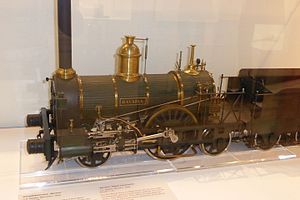Bavarian AI
| AI (Bavaria) LEG - Faust to Wallenstein |
||
|---|---|---|
| Numbering: | Name, inventory number 1-24 |
DER MÜNCHNER, inventory no . 25th |
| Number: | 24 | 1 |
| Manufacturer: | Kessler , Maffei , Meyer | Maffei |
| Years of construction: | 1844-1845 | 1841 |
| Retirement: | until 1878 (partly due to renovation) |
1859 |
| Design type: | 1A1 n2 | |
| Gauge : | 1,435 mm ( standard gauge ) | |
| Length over buffers: | 9,739 mm | |
| Service mass: | 15.0 / 20.5 t | 13.8 t |
| Friction mass: | 7.5 t | 6.8 |
| Top speed: | 40 km / h | 59 km / h |
| Indexed performance: | 75 kW | |
| Driving wheel diameter: | 1,524 mm | |
| Impeller diameter (front): | 915 mm | |
| Impeller diameter (rear): | 915 mm | |
| Number of cylinders: | 2 | |
| Cylinder diameter: | 318 mm | 305 mm |
| Piston stroke: | 559 mm | 457 mm |
| Boiler overpressure: | 6.3 bar | 6 bar |
| Grate area: | 0.72-0.83 m² | 0.93 m² |
| Evaporation heating surface: | 71.00 m² | 46.00 m² |
| Tender design: | 2 T 3.35 | 2 T 3 |
| Water: | 3.35 m³ | 3.0 m³ |
In the genus AI , the associated Royal Bavarian State Railways 1847, the acquired before that date locomotives with a driven axle with the introduction of a label system. In addition to 24 largely identical locomotives from three different manufacturers, the first DER MÜNCHNER locomotive manufactured by Maffei in Bavaria was also classified in this category.
history
The three manufacturers Keßler , Maffei and Meyer each produced eight vehicles with the condition that the parts of the various machines were interchangeable. They reached a speed of 33 km / h on a track with an incline of 1: 200. The first machine was retired and scrapped in 1871. Another five copies were converted to locomotives of the class B I and four more to C I and four were sold. The last one was scrapped in 1874.
In March 1872 the royal privileged Ludwigs-Eisenbahn-Gesellschaft (LEG) acquired a locomotive with the name Faust in Nuremberg . Because it performed well, LEG acquired two more locomotives in October 1873 with the names Henlein (or Peter Henlein ) and Wallenstein . All three locomotives were built in 1845. The Wallenstein was made by Kessler, while the other two were made by Maffei. The Henlein was the first to be retired in 1880 and replaced by the new Pegnitz B-n2t locomotive . Faust followed in 1881 and was replaced by Franconia on September 15, 1881 . The last to be taken out of service at the end of July 1885, after a total of 40 years of service, was the Wallenstein and replaced by the Daniel Ley 1B tank locomotive .
They were with a Tender equipped to type 2 T 3.35.
The Munich was given inventory number 25. It was originally built for the Munich-Augsburger Eisenbahn-Gesellschaft . In 1844 the company was taken over by the State Railways and the machine became their property. A large part of the locomotive came from England , which could be recognized by the typically English pear shape of the standing kettle. She was equipped with a type 2 T 3 tender.
Web links
Individual evidence
- ^ A b Lothar Spielhoff: Länderbahn steam locomotives . tape 2 . Baden, Bavaria, Palatinate and Württemberg. Weltbild, Augsburg 1995, ISBN 3-89350-819-8 , p. 23 (first edition: Franckh-Kosmos, Stuttgart 1990).
- ↑ Chronicle of the Steam Locomotives . HEEL Verlag GmbH, Königswinter 2008, ISBN 978-3-89880-894-1 , p. 23 .
- ^ Lothar Spielhoff: Länderbahn steam locomotives . tape 2 . Baden, Bavaria, Palatinate and Württemberg. Weltbild, Augsburg 1995, ISBN 3-89350-819-8 , p. 24 (first edition: Franckh-Kosmos, Stuttgart 1990).
